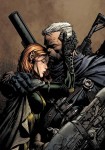Marvel Comics has seen an increase in mainstream popularity with the recent release of several box office hits, such as “The Avengers.” Since its inception in 1939, the comic book company has created thousands of characters. While not all of them may get their due publicity because of a lack of exposure on the silver screen, each has interesting stories to tell in the print medium.
I don’t remember how many years ago it was when I first read parts of the origin stories of Hope Summers, but I liked it enough to spend my weekend giving it a reread.
On this second go, it took me four straight days of intense reading to complete the 46 issues that constitute Hope Summers’ 17-year sojourn into the future, starting as a baby and eventually returning to the present as the teenage Mutant Messiah. But the story is compelling enough that it never drags on.
Though this story arc is primarily intended to establish Hope as a mainstay in Marvel’s X-Men mythos, I think it definitely helped reinvent Cable as well and give the character a new direction since the culmination of “Cable & Deadpool.” Although Cable starts out as Hope’s caretaker, he eventually begins to develop a father-daughter dynamic that still endures in recent comics, even though the story arc ended four years ago.
So let’s start from the beginning of Hope and Cable’s adventure; how do you introduce a character who starts a story with more diapers than dialogue? Turns out it’s by using the emotions of people surrounding her.
We have Lucas Bishop, who was once a hero but turns evil because he is so misguided by his conviction that Hope must be killed. The former X-Man is established early as a clear-cut antagonist whose despicable acts make it much easier to root against him and feel sympathy for the principle protagonists.
As for Cable, he’d be the first person to remind you he’s a soldier first. If his words can’t convince you, his meticulous planning and tactical mind might do the trick. He initially assumes the role of Hope’s protector believing she will be the savior of all mutants, but eventually develops a fatherly bond with the girl, which opens up a layer of vulnerability to the soldier throughout the story.
We see an example of this in “Cable” Volume 2, Issue 6. Cable, with a gun in one hand and Hope in the other, has his eyes fixed on the foes that outnumber him. But the cries of the girl who just dropped the makeshift doll her father gave her distracts Cable long enough for his enemies to blow his cover. Another glance at tearful Hope convinces the soldier to hold off escaping and take out his assailants in order to retrieve the doll.
Cable does, however, make an effort to distance himself from Hope. He doesn’t teach her to call him “father” or “dad.” Instead, Cable instructs Hope to address him by his name, “Nathan,” or as the toddler is shown in the panel only managing, “Nay-Nay.” However the distance that Cable initially tries to place between himself and Hope ultimately loses out to the organic father-daughter bond that develops over the “Cable” series. In the final panel of “Cable” Volume 2, Issue 20, a teenage Hope ends the series by calling Cable “Dad” for the first time as they make their return to the present.
While Hope does have a tendency to get lost as the kid among her grown-up co-stars, she does get some solo moments to shine before growing into her own role. In one instance, Cable passes out from thirst, and Hopes’ inner monologue detailing her thought process as she searches for drinkable water displays the resourcefulness she learned from Cable over the years as a largely silent character.
In part two of “X-Men: Hope,” she laments how harsh Cable is when he trains her, and how he never expresses words of encouragement. As the training continues, Hope finds a way to outsmart Cable, who doesn’t say much as a response. As he turns to face a window, Hope catches a smile on Cable’s reflection and she realizes he never needed to say those words after all.
Hope and Cable’s father-daughter dynamic continues in the story arc immediately following their return to the present. Cable chastises her for getting distracted while they raid a store for provisions, only realizing after she storms off that she’s been so busy spending her life on the run for survival that seeing a simple “Hair Beauty Set” mesmerizes her. In a redeeming moment later in the issue, Cable apologizes for yelling at Hope and tries to make up by giving her the “Hair Beauty Set” she was eyeing earlier – it was the moment I’d been waiting for since the previous panel.
Ultimately, Marvel does a fantastic job in introducing Hope into its universe. Writing a story where the central theme is the growing love between a father and daughter makes Hope’s origin stories engaging and relatable. At the same time it gives readers a reason to care for the characters and gave Hope and Cable a foundation to base future stories on.
